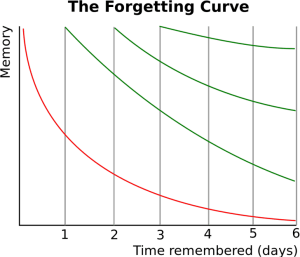Why Microlearning is Made for Corporate Training

Microlearning enhances the learning absorption process and retention of the three main forms of corporate training; induction, upgrading skills, and multi-skilling.
Hermann Ebbinghaus developed the ‘Forgetting Curve‘ (fig.1), where he hypothesized various factors, such as meaningfulness, representation, and physiological actors, can all affect the rate of forgetting. Ebbinghaus concluded that the two most effective ways to increase memory strength are spaced repetition and better memory representation. These two factors are key components of microlearning.

In light of Ebbinghaus’ research, 90% of what one has learned within a week is forgotten. This is why the most effective medium of corporate training is, in fact, microlearning.
Microlearning in corporate training
Microlearning is used in corporate training to ensure that short and memorable chunks of information are presented to a learner at spaced intervals which reinforces learning. Just as the curve is starting to drop off microlearning kicks in. This allows people to keep information in front of mind until it is committed to long-term memory. One of the easiest and most useful ways to deliver this to learners is via mobile. What better way to reach people?
Looking beyond microlearning modules being mobile, they also support just-in-time (JIT) learning, which is essentially being able to make knowledge readily available on-demand.
Scenario 1:
A sales representative is waiting to pitch her product to a potential buyer. They run through the possible questions the buyer will ask and expects to be asked why her company’s product is more effective than the company’s next door. The sales rep accesses her on-demand learning module and is able to answer the question with statistics and accurate facts, allowing her to better answer the question than she would have otherwise.
Microlearning modules can also efficiently close learning gaps. This means that knowledge can be consolidated in a short period to reinforce prior learning.
Scenario 2:
A newly-graduated professor is giving a presentation to a room of 300 university students about a concept he has not covered in depth in a considerable amount of time. He has been more busy than usual lately, so consequently has not had much time to prepare. It is the morning of the presentation and he needs to make sure he is prepared with the correct and current information. Professor accesses his learning module and is able to close the learning gaps he may have had.
Want to know more?
If you’re fed up with dealing with complex authoring practices and ineffective learning, get in touch at enquiries@edapp.com. You can also try EdApp’s Mobile LMS and authoring tool for free by signing up here.
Sources
https://www.psychestudy.com/cognitive/memory/ebbinghaus-forgetting-curve
https://elearningindustry.com/microlearning-for-corporate-training
Curated course examples
Author
Guest Author Daniel Brown
Daniel Brown is a senior technical editor and writer that has worked in the education and technology sectors for two decades. Their background experience includes curriculum development and course book creation.
